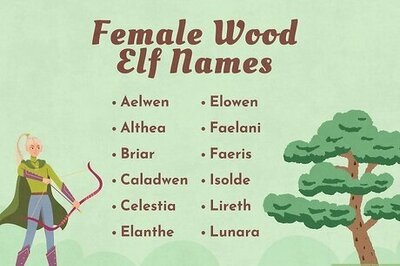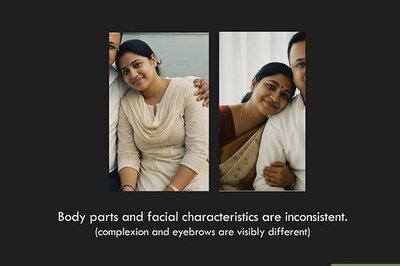
views
Surat/Tapi (Gujarat): In July 2015, youth from Gujarat’s Patidar community came together to launch an agitation seeking reservation under the OBC quota. Before the state government could deal with the political crisis, it snowballed into a state-wide agitation by August and Hardik Patel emerged as a leading voice.
Demonstrations were held across Gujarat’s major districts, including Surat where the diamond and textile markets were shut. But not far from Surat, in the forests of South Gujarat, another community was watching the Patidars very carefully.
The Scheduled Tribes or Adivasis of the state then saw Jignesh Mevani rise as a leader of the Dalit community and Alpesh Thakor as a voice of the OBCs. Thakor and Mevani are in their 30s and Patel is just 24. Seeing the rise of young leaders, willing to take on the mighty state government for their communities, has led Adivasis to realise that their community lacks a single galvanizing face.
“There have been smaller movements by local pro-Adivasi outfits but there is nobody to take their issues to a pan-Gujarat level. What many Adivasis want is a leader to call their own, somebody who, like Jignesh or Hardik, will raise their issues and take on political powers. There is a lot of resentment among Adivasis but nobody to unite them and launch a movement. They did not really feel this pinch until recently but after the Patidar agitation, they have started to feel the need for a leader,” said Romel Sutariya of the Adivasi Kisan Sangharsh Morcha.
Of the 182 Vidhan Sabha seats in Gujarat, 26 are reserved for Scheduled Tribes. In 2012, the Congress won 15 of these seats, the BJP won 10 and the JD (U) grabbed the remaining one seat. Tribals, who make up around 14% of Gujarat’s entire population, essentially decide who rules over these 26 seats in the Adivasi belt.
Activists, however, fear that tribals are divided. “In the early 2000s, tribals in Gujarat joined nationwide protests demanding greater forest rights. The fight for jal, jungle, jameen (water, forest, land) brought them all together. However, since then there has been a long gap and tribals have not seen any young leader emerge from the movement,” said veteran Gandhian and Ahmedabad-based tribal rights activist Ashok Chuadhari.
He added, “The current generation of tribals is the first generation that has even ventured out of the forest, let alone be educated. I feel that if any generation can give leadership to the Adivasis, it is the current young generation. They are young, educated and feel disenfranchised. I hope it results in a sustained struggle.”
According to Sutariya, there are still many issues that tribal populations in Gujarat are grappling with. Over the last few months, “traditional” tribal communities, such as Bhils, Vasavas and Gamits came out to protest against the state government’s decision to grant Secluded Tribe identity cards to members of three pastoral communities dwelling in the Gir forest.
The Bhilistan Tiger Sena, an outfit that demands that a separate state of Bhilistan be carved out of Gujarat, has gone as far as to say that the three pastoral communities – Rabari, Bharwad and Charan – were “fake tribals”.
However, the issues facing tribals run deeper than just quotas getting diluted. Sutariya said, “The Fifth Schedule provides special protection to Scheduled Tribes in scheduled forest areas. However, it wasn’t until 1989 that special protections were actually enforced. In 1989, it was decided that those who had been farming on forest land before 1989 would get the rights to do so legally. In 2002, the deadline was extended and finally, with the passage of the Forest Rights Act (FRA) of 2006, it was decided that the cutoff date would be December 13, 2006. However, in practice, this is hardly enforced.”
He explained further, “There are around 90 lakh tribals in Gujarat. However, since 2006, the state government has only received 1.82 lakh applications of Adivasis claiming forest land. Most of these applications were rejected and the Gujarat government has not accepted any new applications since 2009. If there are 90 lakh tribals in Gujarat, why has Gujarat government granted land to so few?”
The lack of legal literacy among tribals, he said, was the main reason behind the low number of claims. “Most of them don’t know how to apply for land since there is a lot of paperwork and permissions involved. We try to help as many people as we can but we can’t reach every tribal. The state government needs to do more,” Sutariya said.
As a result, a majority of Adivasis are left to farm on forest land “informally” without the proper paperwork. According to Ragubhai Vasava, a former Sarpanch from South Gujarat’s Tapi district, this has created a sort of “free for all” in the forest.
“Those tribes or persons who are dominant end up controlling a much larger share, 10 acres of land for example, while there are those who can only manage to keep a hold of 2-3 acres. There are also many tribals who do not control any land whatsoever. Instead of this free-for-all situation, the government should ensure that land is equitably distributed among all tribals of Gujarat. We don’t need much, since all we grow is jowar and bajra. Even if each tribal gets 3 acres of land, it will be enough for us,” Ragubhai said.
Despite growing criticism, Gujarat Tribal Development Minister Ganpat Vasava defended the BJP government in the state. “No government in Gujarat has done as much for Adivasis as the BJP has. The numbers speak for themselves. Under Narendra Modi Ji as Chief Minister, the Gujarat government distributed 13 lakh hectares of land to Scheduled Tribes. This benefited over 85,000 tribals in the state.”
When asked why the Gujarat government had accepted such few claim forms, Vasava said, “Ever since the Forest Rights Act was passed in 2006, we have seen many instances of people masquerading as tribals to get access to forest land. We have to do two things at the same time – ensure that every genuine Adivasi gets his or her share of forest land and no fake tribal takes advantage of this law.”
In Tapi district, 33-year-old Shraddha Vasava said tribal youth in the state face their own set of problems. With the Gujarat Assembly polls looming, her priorities as a voter are already set. She said, “They say that there are no jobs in the city. If that is the case, imagine how much worse it is for Adivasis. Who will come to the forest to give us land? I am a graduate and have been searching for a job for years but there is no employment. So I am forced to work as a farm hand for my parents. This election, I will vote for the party that can assure me that they will give employment to tribal youth.”




















Comments
0 comment